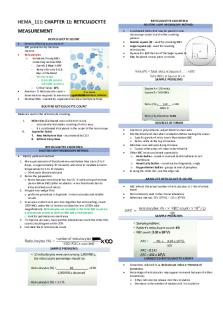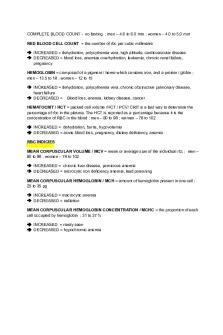CBC worksheet JY-1 - complete blood count PDF

| Title | CBC worksheet JY-1 - complete blood count |
|---|---|
| Author | 재은 유 |
| Course | Fundamentals of Nursing |
| Institution | University of California Los Angeles |
| Pages | 3 |
| File Size | 109.2 KB |
| File Type | |
| Total Downloads | 98 |
| Total Views | 151 |
Summary
complete blood count...
Description
Pasadena City College: NURS 50L Complete Blood Counts Reference Values
WBC
Neutrophils
4.1-10.0
43.0- 76.0
Clinical Problems Decreased Level
Clinical Problems Elevated Level
Autoimmune disorders Bone marrow deficiencies Viral diseases Liver problem Spleen problems Severe bacterial infection Radiation therapy "Neutropenia" an abnormally low count of a type of white blood cell
Infections Cigarette smoking Leukemia Inflammatory diseases Tissue damage Physical/mental stress
It can be caused by diseases that damage the bone marrow, infections, or certain medications
This is a sign that your body has an "active bacterial infection"
"Neutrophilia" having a high percentage of neutrophils in your blood
Bacterial infection Noninfectious inflammation Intoxication from alcohol Excessive production of cortisol (Cushing’s disease)
Eosinophils
0.0-5.0
Parasitic infection Allergic reaction Cancer Basophilic disorders
Basophils
Monocytes
Lymphocytes
0.0-2.0
4.0-13.0
"Eosinophilia" a higher than normal level of eosinophils
Cancer Acute infection Serious injury
"Basophilia" an abnormally high basophil level Chronic inflammation Hypothyroidism
Lower your overall white blood cell count Cancer and other serious diseases that suppress the immune system Chemotherapy Radiation therapy (which can injure bone marrow)
"Monocytosis" when your monocyte level is high
Infections caused by viruses, fungi, parasites, or bacteria
A temporarily high lymphocyte count is a normal effect of your body's immune system working.
17.0-48.0
Viral infections Parasitic infections Chronic inflammatory disease
Leukemia Bleeding, Anemia, Malnutrition, Over hydration, Hemolysis,
Created by Jeong o fall 2013
Dehydration Cigarette smoking Congenital heart disease
Pasadena City College: NURS 50L
RBC
3.9-4.98
MCV size of red blood cell
81-93
MCH shape
28-35
MCHC color
HCT
33-37
35-45
HgB
12-15.5
Platelets
140-400
Erythropoietin deficiency, Leukemia, Multiple myeloma, Porphyria, Thalassemia, Sickle cell anemia Microcytic Iron deficiency anemia Thalassemia Anemia of chronic disease Sideroblastic anemia
MCV=MCH May be low when MCV is low Iron deficiency anemia and thalassemia
Over hydration, Nutritional deficiencies Blood loss Bone marrow suppression Leukemia, Lead poisoning Hodgkin's lymphoma, Chemotherapy
Nutritional deficiencies, Blood loss, Sickle cell anemia Renal Problems Bone marrow suppression Leukemia Lead poisoning Hodgkin's lymphoma Virus Aplastic anemia Leukemia Alcoholism Vitamin B12 & folic acid deficiency SLE, hemolytic uremic condition, HELLP, DIC, vasculitis, sepsis, splenic sequestration, cirrhosis
Pulmonary fibrosis Renal cell carcinoma Polycythemia vera
Macrocytic Vitamin B12 or folate deficiency Hemolytic anemia Liver disease, alcoholism Hypothyroidism Aplastic anemia Myelodysplastic syndrome MCV=MCH (Hyperchromia) are seen in conditions where the hemoglobin is more concentrated inside the red cells: autoimmune hemolytic anemia, burn patients, hereditary spherocytosis Dehydration Hypoxia Cigarette smoking Polycythemia vera Tumors Lung diseases Blood doping, Erythrocytosis Cor pulmonale Dehydration Cigarette smoking Polycythemia vera Tumors Erythropoietin abuse Lung disease Blood doping Cancer, allergic reactions, polycythemia vera, recent spleen removal, chronic myelogenous leukemia, inflammation, secondary thrombocytosis
Answer to the following questions:
What is the Kidney function in RBC production?
Healthy kidneys produce a hormone called erythropoietin, which stimulates the bone marrow to make red blood cells needed to carry oxygen throughout the body.
Created by Jeong o fall 2013
Pasadena City College: NURS 50L
What does a “shift to the left” signify & suggest?
The term "shift to the left" is used when determining if a patient has an inflammatory process. It indicates a marked increase in the percentage of immature cells in the circulating blood, meaning an infection in progress. (young/immature white blood cells present. It means that there is an infection or inflammation present, and the bone marrow is producing more WBCs and releasing them into the blood before they are fully mature)
What is the purpose of the differential?
A CBC with differential is used to help diagnose and monitor many different conditions.
What is the polycythemia & what does polycythemia cause?
Polycythemia vera is a rare blood disorder in which there is an increase in all blood cells, particularly red blood cells. The increase in blood cells makes your blood thicker. This can lead to strokes or tissue and organ damage
Medication to increase (sub Q injection) to boost wbc number Neupogen is a man-made form of a protein that stimulates the growth of white blood cells in your body used to treat neutropenia
Red blood cell size, shape, color Platelet cell in the blood that form clot and stop bleeding
Created by Jeong o fall 2013...
Similar Free PDFs

Blood Typing Worksheet
- 2 Pages

Blood Transfusion worksheet
- 4 Pages

01 Chordates Worksheet Complete
- 2 Pages

Heart and Blood Vessel Worksheet
- 2 Pages

**PAL Blood Worksheet I KEY
- 11 Pages

Reticulocyte Count
- 2 Pages

2 - Count Zero Pdf
- 183 Pages

HEMA Reticulocyte Count
- 2 Pages
Popular Institutions
- Tinajero National High School - Annex
- Politeknik Caltex Riau
- Yokohama City University
- SGT University
- University of Al-Qadisiyah
- Divine Word College of Vigan
- Techniek College Rotterdam
- Universidade de Santiago
- Universiti Teknologi MARA Cawangan Johor Kampus Pasir Gudang
- Poltekkes Kemenkes Yogyakarta
- Baguio City National High School
- Colegio san marcos
- preparatoria uno
- Centro de Bachillerato Tecnológico Industrial y de Servicios No. 107
- Dalian Maritime University
- Quang Trung Secondary School
- Colegio Tecnológico en Informática
- Corporación Regional de Educación Superior
- Grupo CEDVA
- Dar Al Uloom University
- Centro de Estudios Preuniversitarios de la Universidad Nacional de Ingeniería
- 上智大学
- Aakash International School, Nuna Majara
- San Felipe Neri Catholic School
- Kang Chiao International School - New Taipei City
- Misamis Occidental National High School
- Institución Educativa Escuela Normal Juan Ladrilleros
- Kolehiyo ng Pantukan
- Batanes State College
- Instituto Continental
- Sekolah Menengah Kejuruan Kesehatan Kaltara (Tarakan)
- Colegio de La Inmaculada Concepcion - Cebu







